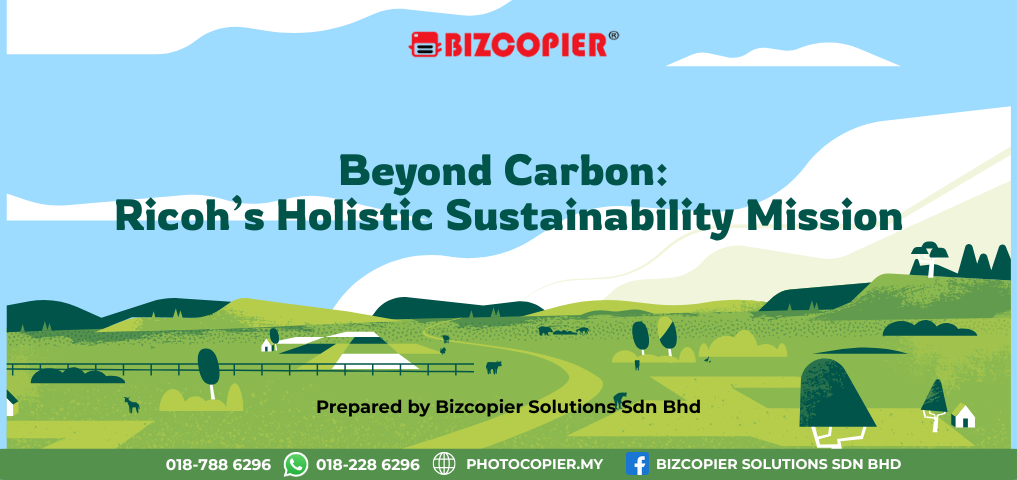Beyond Carbon: Ricoh’s Holistic Sustainability Mission

In a world where carbon neutrality has become a buzzword, Ricoh is pushing beyond the basics. For this global tech leader, sustainability isn’t just about cutting emissions — it’s about redefining how a company behaves, builds, and benefits the world around it.
Ricoh’s sustainability strategy is holistic, embedded into every layer of its business — from product design and supply chains to workplace innovation and social equity. This isn’t a campaign. It’s a mission.
🌍 More Than Emissions: Redefining Sustainability
Ricoh believes sustainability isn’t just about carbon footprints — it’s about corporate responsibility, circular systems, ethical innovation, and lasting value.
While reducing CO₂ is critical (and Ricoh has aggressive net-zero targets), the company’s mission also focuses on:
Circular economy practices
Resource conservation and product longevity
Social impact and human rights
Biodiversity protection and clean water access
Sustainable supplier partnerships
It’s an ecosystem approach — one that doesn’t isolate the environment from the business, but integrates it into every decision.
🔁 Circular Thinking in a Linear World
At the heart of Ricoh’s sustainability drive is its commitment to the circular economy — designing products and services that minimize waste and maximize reuse.
This means:
Remanufacturing and refurbishing devices to extend life cycles (e.g., Ricoh’s GreenLine products)
Using recyclable materials and reducing single-use plastics
Designing devices for modularity and easy repair
Implementing global take-back programs for used equipment
The result? Less landfill, lower resource demand, and a more responsible model for the tech industry.
♻ Product Innovation with Planet Impact
Ricoh’s product innovation is guided not just by performance, but by planet-conscious design. Every new generation of Ricoh printers, MFPs, and workplace tech is built with:
Energy efficiency as standard
Lower emissions across the product lifecycle
Smart features that reduce waste (like duplex defaults, print optimization, and usage analytics)
Sustainable packaging and shipping practices
Ricoh doesn’t just ask, “What will this product do?” It asks, “What impact will it have from cradle to grave?”
🧠 Sustainable Workstyles: Helping Customers Go Green
Ricoh isn’t just transforming itself — it’s helping its customers do the same.
Through its digital workplace solutions, Ricoh enables organizations to:
Digitize paper-heavy processes
Reduce travel through remote collaboration tech
Monitor and manage print environments for waste reduction
Consolidate infrastructure to reduce energy use
By integrating sustainability into productivity, Ricoh shows that efficiency and responsibility can go hand-in-hand.
👥 People, Planet, Progress: A Broader Responsibility
Ricoh’s sustainability mission extends into social impact as well:
It promotes diversity, equity, and inclusion internally and with partners
Upholds labor and human rights standards across global supply chains
Invests in education, disaster recovery, and clean water initiatives worldwide
Collaborates with the UN and other organizations to meet Sustainable Development Goals (SDGs)
For Ricoh, sustainability includes people and communities, not just the environment.
🏁 The Road to 2050: Ambitious but Grounded
Ricoh has committed to net-zero greenhouse gas emissions by 2050, with bold interim targets for 2030. Its strategy includes:
Switching to 100% renewable energy
Electrifying its logistics and fleet operations
Leveraging science-based targets to stay aligned with climate science
Transparent, third-party verified ESG reporting
This isn’t a vague vision. It’s measurable, accountable, and mission-critical.
🔚 Final Thought: The Sustainability Standard of the Future
Sustainability isn’t just part of Ricoh’s business. It is the business. From smart printers to cloud platforms, from AI to ethical sourcing, Ricoh is proving that a company can innovate, grow, and lead without compromising the future.
In going beyond carbon, Ricoh is creating a model other businesses can follow — not just to survive in a green economy, but to thrive in it.

Recent Comments